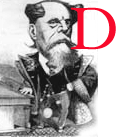 ickens moved
his family and staff from the the Villa Bagnerello in the rural suburb of Albaro to the Villa Pallavicino della Peschiere, on 23 September 1844 amid thunder, lightning, and rain.
In a letter of 7 August 1844 to the Count D'Orsay, Dickens explained that because the Villa Bagnerello in Albaro
ickens moved
his family and staff from the the Villa Bagnerello in the rural suburb of Albaro to the Villa Pallavicino della Peschiere, on 23 September 1844 amid thunder, lightning, and rain.
In a letter of 7 August 1844 to the Count D'Orsay, Dickens explained that because the Villa Bagnerello in Albaro
would never do for a winter residence . . . I have been looking about me, and have concluded an arrangement, I hope, for the Peschiere: entering on the possession of that Palazzo, on the first of October. I have the whole Palace except the Ground Piano. I don't know whether you ever saw the rooms. They are very splendid indeed; and every inch of the walls is painted in fresco. The Gardens also, are beautiful.
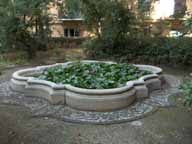
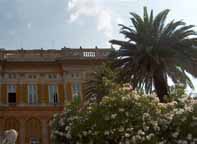
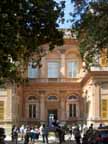
The villa (or palazzo) received its two names from its architect, Tobia Pallavicino, and from its many garden fishponds. The paintings to which Dickens refers were in fact produced by two well-known sixteenth-century artists — the renowned Renaissance painter Luca Cambiaso (1527-85) and Giovanni Battista Castello (1509-69), often called simply "il Bergamasco" from his birthplace. They decorated the walls and ceilings of the lower floor and of the upper "piano nobile" at Genoese Villa Pallavicino della Peschiere, so named because of its many garden fishponds and its architect, Tobia Pallavicino. The villa's brightly coloured antique frescoes recall in their mythological subjects and pastoral landscapes those of Peruzzi's Villa Farnesina in Rome. Because its decorations influenced some of Dickens's writing, the Peschiere has more than biographical interest alone for readers of Dickens.
Dickens reserved the eastern room off the Grand Sala for his bedroom and the western room, with its superior afternoon lighting, as his study. The Ovidian frescoes in "the two best bed-rooms" (Life 227) which Dickens briefly but enthusiastically described to his London correspondent John Forster must be considered as part of the context of his composition of the second Christmas Book, The Chimes, which he had contracted to write for his new publishers, Bradbury and Evans, early in the previous May. Although Dickens had used the enforced isolation of the Bagnerello to ponder what he might write, he had had little leisure for extended work because his favourite child, Katey, had fallen seriously ill (perhaps from drinking unpasteurized milk in quantity) and had insisted that only her father should nurse her. Her neck badly swollen, her cries were hardly conducive to the peace of mind Dickens required to begin formulating his "second Carol." Fortunately, she had recovered by the end of August, just weeks before the family packed for the removal to the larger, far more prestigious villa within Genoa's walls. This suffering child may have become Meggy 's infant in Trotty's dream vision and, as clever and determined as her father, may also have been the basis for the spiritual guide of The Chimes, Lilian.
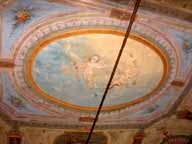 /
/
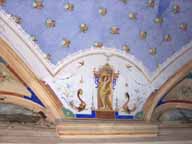
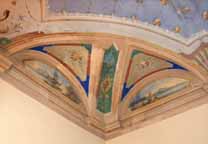
Frescoes from the Bagnerello. [Click on the thumbnails for larger images.]
Whereas the frescoes in the Bagnerello are cheerful but pedestrian depictions of generalized nymphs and swains against sketchy pastoral backdrops, those in the Peschiere, the work of decorative masters of the High Renaissance, have both literary and local associations. In particular, Bergamasco's "The Fall of Phaeton directly above the Dickenses' bed has a Ligurian as well as an Ovidian connection; visually the urban and suburban landscape with towering mountains behind suggests the physical situation of Genoa itself, while narratively the cousin who mourned the death of the imprudent Phaeton was Cycnus, the King of Liguria (Metamorphoses, Book Two), who was transformed into a swan on the banks of the Po.
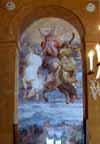

Left: Diana Wrestling a Satyr by Luca Cambiaso (1527-85)
Right: The Fall of Phaeton by Giovanni Battista Castello (1509-69). [Click on the thumbnails for larger images.]
This fresco, associated with the catastrophic careering over the chariot of Helios out of its proper path, is located in the eastern bedroom, and is associated with dawn, its lighting a delicate shade of blue in the aerial perspective of the mountains in the background, with richer tones for the city buildings in the foreground. In contrast, Cambiaso's Diana Wrestling a Satyr above the entrance inside the western bedroom has flesh tones and reds reminiscent of Titian's work, and consonant with the warm, late afternoon sunshine that would have spilled into the room over the rooftops of the city in front. Both frescoes exemplify the issue of appropriate and inappropriate uses of power, with the Bergamasco picture implying the dire consequences of the misuse of power not only in the fate of the inverted youth at the top but of the peasants below who run from the scene, fearful that the remnants of the Sun's chariot will fall upon them. When Dickens's secondary characters, Alderman Cute and Sir Joseph Bowley, in The Chimes abuse their power, Dickens's sympathies lie with the working-class characters who feel powerless against the forces of the establishment, in particular with Trotty Veck, who, as a spirit in the dream vision, cannot intervene to assist Lilian, Will, Meggy, and Richard. Poverty-stricken and unemployed, Will cannot escape the catch-and-release cycle of the seasonally-employed, marginalized rural labourer. Despite their working hard, Meggy and her alcoholic fiancé Richard cannot recover their wasted youths and love. And Lilian cannot escape her only means of livelihood, prostitution. When we first encounter Trotty Veck, he is shivering in the cold, hoping (like Dickens in his glorious study) that some commission will providentially turn up. Not able to get down to work, Dickens welcomed with great relief the auditorially-stimulated vision of The Chimes as much as Trotty is delighted when Alderman Cute hires him to deliver a letter.
In Cambiaso's fresco above the study's lintel, the indignant goddess Diana, the Roman version of the Greek Artemis, identifiable by her "little crescent-shaped horns" (Rose 121), asserts her authority over her surly adversary as she prepares to deliver him a knock-out punch. We note that Dickens, perhaps subconsciously under the influence of this fresco, spoke of "making, in this little book, a great blow for the poor" ("To John Forster, [?13-14 October 1844]," Letters 4: 200), hoping that the second Christmas Book would, like the moon goddess in this picture, have "a grip upon the very throat" upon its opponents, the complacent, self-serving, upper-middle-class and aristocratic authorities who exploit the or neglect the working poor. As he chose these phrases, he would have been writing to Forster at his desk at the window, just to the right of Cambiaso's fresco, one of the few in the villa both designed and executed by the maestro rather than Bergamasco. It is a masterpiece of pre-Baroque energy conveying a sense of the physical power and determination of the larger-than-life adversaries.
While Phaeton in Bergamasco's picture, having squandered his god-given power and behaved without regard for the rest of humanity, is shown in a tragic free-fall, the almost triumphant Diana is employing both muscular arms to vanquish the figure emblematic of unrestrained passion and licence. The maestro has captured the heroic figures in violent emotion and swirling action with only the shadows of the wrestlers as backdrop. Bergamasco 's tranquil pastoral scene--a Ligurian fishing village--on the bedroom's shutters which hide the altar would for Charles and Catherine Dickens have contrasted the violence and drama of the scene above their headboard. The death of the handsome youth may have even partly stimulated Dickens to dream of Mary Hogarth as a Raphael Madonna in that same room.
No one knows exactly when Dickens actually dreamed of Mary. Was it in his first night at the Peschiere, by Forster's dating 23 September (one week prior to the letter from Dickens to Forster, 30 September 1844), or somewhat earlier, at the Bagnerello? On 1 September 1844, Dickens wrote to Samuel Rogers that he had leased the Peschiere "for the next six months" (Letters, 4: 189), but he specifically mentions to Thomas Mitton in a letter dated 12 August that he will "enter on the possesson of, on the 1st. of October, and hold until the sixteenth of March, at 5 Guineas a week" (176) the rooms in the Peschiere being vacated early by "an English Colonel who is going away" (176). It is not likely that the colonel, "a great Bozonian" (177) and therefore eager to accommodate Dickdens, might have vacated the premises several weeks in advance of the date upon which Dickens was originally expecting to move from Albaro, namely "on the first of October" ("To Count D'Orsay," 7 August 1844, Letters, 4: 167). Unfortunately, the accommodating English colonel has never been identified, so acquiring corroborating correspondence from that quarter has so far proven impossible for the editors of the Pilgrim Edition of the Letters of Charles Dickens.
Related Material
- Views of Palazzo Peschiere and Genoa: A Gallery
- The Strada Nuova ("The Streets of Palaces") (Dickens's Pictures from Italy)
- Dickens and Family at the Villa di Bella Vista, July-September 1844
- "The first impressions of such a place as Albaro" (Dickens's Pictures from Italy)
- Charles Dickens's Tours of Italy
References
Ackroyd, Peter. Dickens,/span>. London: Sinclair-Stevenson, 1990.
Dickens, Charles. American Notes and Pictures from Italy. The Works of Charles Dickens in Thirty Volumes. New York: P. F. Collier and Son, n. d. [Pictures from Italy was originally published in volume form by Bradbury and Evans, London, in May 1846, after appearing intermittently in the Daily News, London, from 21 January to 11 March 1846]. Vol. 20.
_____. The Chimes: or A Goblin Story of Some Bells That Rang An Old Year Out and A New Year In. The Christmas Books, ed. Michael Slater. Harmondsworth: Penguin, 1971, rpt., 1978. Volume One, pp. 137-252.
_____. The Chimes: or A Goblin Story of Some Bells That Rang An Old Year Out and A New Year In. London: Chapman and Hall, 1845.
_____. The Pilgrim Letters, ed. Madeline House, Graham Storey, and Kathleen Tillotson. Oxford: Clarendon, 1974 and 1977. Vol. 3 (1842-1843) and 4 (1844-1846).
Forno, Ilaria. No. 100: "Villa Pallavicino delle Peschiere." Genova Architectural Guide, ed. Lorenzo Capellini and Ennio Poleggi. Genova: Umberto Allemandi, 1998. P. 140.
Forster, John. The Life of Charles Dickens. 2 vols. London: Chapman and Hall, n. d. (originally published in 3 vols., 1872-74).
Ovid. The Metamorphoses, trans. Horace Gregory. New York and Scarborough, ON: New American Library, 1960.
Parker, David. Christmas and Charles Dickens. AMS Studies in the Nineteenth Century, No. 34. New York: AMS Press, 2006.
Rose, H. J. A Handbook of Greek Mythology. London: Methuen, 1983.
Slater, Michael (ed.). The Christmas Books of Charles Dickens. Harmondsworth: Penguin, 1981. Vol. 1: The Chimes. Pp. 137-255.
_____. "Dickens (and Forster) At Work on The Chimes." Dickens Studies Annual 2 (1966): 106-40.
Last modified 24 July 2005
Last modified 17 July 2007